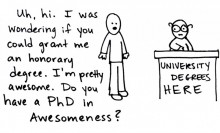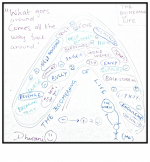
Hate
in Mindfulness
It’s again about the nature of energies that I’m going to talk about.Yet another emphasis about the importance of positive energy. But I felt it was important to see it from the perspective of hate. Hence this post.
There’s no one that can escape Mr. Hate. Let’s face it. There’s at least someone we have hated at some point of life – even if it is for just a second, hate is hate. Likewise, there’s at least someone in the world that hates us – for reasons known and unknown, petty and big, true and untrue. No matter what, hate is after all hate.
While we are striving hard to achieve peace, what do we do when this Mr. Hate blocks our way?
The answer is the same as that of any other obstacle – positive energy. While our efforts must lie on the path of solving the problem that created the hate, we must not forget to carry our bag of eternal positive energy. Because, this bag, is after all, our powerhouse. It is our inspiration, friend, and every lost link in the world.
There are different “types” of hate exhibited by people.
There are some that express hate right on to the face. Straight forward haters are my favourites. These are very easily solvable. If this hate has emerged out of a misunderstanding, the very expression of the hate would lead to its destruction, rather than its accumulation – or what is called “bottling up”. As people popularly say “It is better to be slapped by the truth than to be comforted by a lie.”
Then there are these haters that never express hate directly, but reveal the feeling through indirect means. Sarcastic haters certainly express hate, but we must be shrewd enough to understand it. If we do, and maintain our calm, we can solve the problem to the extent we can. They either express hate through facial expressions, or through sarcastic speech – or by other indirect methods such as finding every possible way to avoid you.
Then there are some others who never let out their hate. I call them the volcanic haters. You never realise that there was lava until it erupts one day. They would be nice to you all the way long, while suppressing their hate within. When they can no longer hold it, they throw it all upon you. That’s when you’d feel that they’re probably behaving so because they’re not well at that moment. But the truth is – it hasn’t come out of the blue. These people are very dangerous, I tell you. We must be strong enough to be stable even when such outbreaks take place. Handling this could be very tricky, especially if we have a lot of our trust and love deposited in them.
And then there is this last category of haters – people who somehow hide their hatred throughout their lifetime. They keep on generating negativity – always unexpressed. This harms both parties. Highly dangerous. But it is the sad truth!
The solution to everything lies in the nature of thoughts we create. While we can strive hard to solve the problems that arise with people who talk right on to the face, we must ensure that we don’t lose our calm when they let out their thinking. After all, we saw how horrible it is to hide the hate. So when someone lets out their hate – we need to remember that we’re lucky to have a hater that expresses! For all the categories where the hatred cannot be possibly removed by mere talking, the best is to ignore. Ignore here means – never hate back. When we don’t hate back, we need to have the stability to think and understand that if there’s no fault on our side, we don’t need to bother.However, if we are at fault – let’s not think twice for an apology – a sincere heartfelt apology.
Any hater is directing negative energy towards you. Without responding to it by further negative energy, we need to continue positive energy. On more practical terms – we need to understand that this hatred has emerged out of some misunderstanding or ignorance – or difference of opinion. Whether or not attempting to solve it, we need to remain calm. Mere happy acceptance solves our problem.
Whether expressed or unexpressed, hate is driving negative energy towards us. After all, the hate is directed towards us. So we need to create a wall of positive energy around us. In another words – we need to overflow with positive energy. When we are surrounded by positive energy, not only do we spread the love, but also shield ourselves. Let the arrows come! They aren’t going to penetrate.
When they see a nil-response (in terms of hate), it is possible that the intensity of the hatred reduces. Highest probability is that their hate is magically converted into love. If not love – into null. If not null – at least suppressed. And if not suppressed – we are unaffected anyway. I don’t intend talking about selfish ideas here. But the above sentence means that positive energy is the key to everything. It is the degree and strength of the positive-energy-shield that we create, that decides the degree of impact. Not to mention, this is to be supplemented by other means of solving the problem – ALWAYS backed by positive energy.

“What? You are not upset??”
in Mindfulness
#globalite Dhwani is back with another profound post on attachment and the secret of happiness.
I heard from someone today, an emphasis on the importance of what is called “home”. They said that there are two words whose very utterance creates a gush of emotions within – “ma” (mother), and “ghar” (home). While describing the difference between a ‘makaan’ (house) and a ‘ghar’ (home), they said that a home is something beyond a structure of walls and doors. A home is that which comforts each atom of the body. A home is that which provides solace. A home is that whose every component provides love. The doors and the walls express motherhood, and provide a secure feeling. An inhabitant gets attached to every bit of the house. The longer someone stays in a house, the more do they get attached to it. Pondering over these lines reminded me of what my friend asked me a few months back, when our family moved from one house to another. The two houses are at least 10 kilometres away from each other. And there is no similarity between them. No similarity in the structure, no similarity in the surroundings – nothing in common at all. When I told my friend that I do not have any hard feelings on shifting, my friend saw me as if I was inhuman. I was asked how it was even possible to not have attachments to the surroundings in which I lived for almost ten years.
And then I had to face psychological interpretations from my friends…One said, “You will feel the difference later. You may not feel sad now. But you will miss your old house later.” And then there was this other friend who said, “Are you human?? How can you not be sad??” And then there were these people who thought I was abnormal, and tried “helping” me, by trying to make me miss the house and feel bad about the departure. “Think about it..this was the house in which you grew up..this was the house in which you played…this was……blah blah..” (It was actually sweet of them 😀 )
All I could do at that situation was to smile outside and laugh inside. Now that I am not facing the incoming gush of reactions to my state of mind, I can take time to explain what according to me is the reality in this concern. It is the same thought process I went through months back while shifting, that I went through on hearing the speaker today.
In absolute reality, a home is but a structure of bricks and cement. Yes, we give life to the house by elements such as love, care, and brotherhood – which is when we call it a ‘home’ rather than just a ‘house’. But essentially, this whole structure is divisible into two aspects – the physical aspect (bricks and cement) and the mental aspect (which makes at a home). If we give it a little thought, it is pretty obvious that it is not the physical component that we are attached to. When we say that we are attached to the beauty of the house, we actually intend to imply that we are attached to the memories we created somewhere amidst this beauty. If we say that we are attached to every ‘brick’ of the house (as we hear from people who build their own house), we actually intend saying that we are attached to the deep thoughts that went in, at the time of construction. We are attached to the dreams we dreamt while building each corner of the house. We are attached to the conversations that took place then. If the kitchen would remind us of our mother, we are attached to the motherhood in the kitchen, which was generated by the mother. Before we began residing, the building was devoid of any of this. If we are shifting, we are leaving the house as a building, and not as a home. Because in reality, all the components that created these memories are still with us. We still possess every factor that transformed the house into a home. The love is still in our minds. Care, compassion, happiness, thoughts, wishes, motherhood, brotherhood – nothing was native to the house. It was all generated by our own minds – which we still possess. We do not leave our instincts behind, when we empty a house. We don’t leave our brotherhood behind. We don’t leave our love behind. Indeed, we create these emotions. And these emotions can be created absolutely anywhere. And any place we go to could make us feel “at home”, when we realise this. We possess within us, all that we are essentially attached to.
With our own minds, thoughts, words, and actions, we are complete beings. We do not need the house to define us. We do not need a building to give us identity. We are not known by our houses. We are known by our actions, by our words…and essentially, by our thoughts, for after all – thoughts are the roots of words and actions, which create events that become memories.
So, here is the base.
This is why I do not need to miss the house in which I played. It can anyway not be the same tomorrow. The time I spent today playing is not the same I would spend tomorrow, even if it is in the same place, with the same people, and the same game. Once the action is complete, it is anyway just a memory. And I can create millions of such memories wherever I go. Because after all, ALL of this is self-created. Love, happiness, sorrow… everything is brought upon by ourselves. The house was just at the background of it all. In absolute reality, it had no role to play in any of these events. So getting attached to a lifeless building just because it was part of our memories, and thereby increasing our sorrow during events such as shifting, is completely just a waste of precious mental energy, and is completely avoidable. If it is inevitable to shift, be it so. Let’s do it without hard feelings! The same can be applied to any materialistic attachment… for instance, some people get too attached to their articles that they find it hard to let go, even when they know that they are left with no other choice. This includes automobiles, electronic devices, and so many more. There is, in reality, no use in missing the past. There is, in reality, no need to suffer to let go. Memories are just memories. To relive the past is futile.
After all, buddies, life is too short to be spent in grief. And wherever we know we can avoid ill feelings, let’s do it! Instead of filling ourselves with sorrow of letting go of something we cannot hold still on to, let’s look at the future. Let’s fill ourselves with the excitement for what’s in store.
Just like a river looks different in every region of its flow, our life too, would be completely different at different points of time (in fact, variations are instantaneously created). The river does not stagnate at the mountain top just because it enjoys the view from the height. It continues to flow, and experiences the joy of nourishing so many places, enriching so many more lands, and giving happiness, solace, and life to so many beings. It has a joyful journey and ends in a place completely different from its starting point. So does our life go. Entirely different at each point. We cannot stagnate. We move. Let our minds move too. If we are physically busy with the new, and mentally engaged in the old, it just does not match. Let’s keep it simple. We need to give a smile and move on 🙂 ………….and! if someone is not upset, let them be 😀 “happy” is always good. Trust me, they are sane 😀

Relevance of Ayurveda for a healthy life
in Health, Life Style
#globalite Dhwani is a student of Ayurveda and explains the benefits of #Ayurveda for a #healthy #lifestyle
A sunny afternoon it is, and I am in a building on a busy road. A peek outside the window, and the scene I see has diverse elements. There are people, people, and people everywhere. Vehicles and garbage fill the road, smoke and dust fill the air. I feel sonder. There’s a hospital on the opposite side, and I see people rushing in and out. There’s distress everywhere. There is not the slightest indication of the presence of happiness. Thinking of the world that lies beyond this street, we realize that this is the story of almost every place on our planet today. Misery – the word defines our times. Misery brings down efficiency on all spheres of life. Misery depresses, misery burdens, misery kills.
One of the most significant and apparent cause of this seemingly omnipresent misery is – improper health. More so, when we look deeply into the definition of health stated by the World Health Organisation (WHO). It defines health as a state of complete physical, mental, and social well-being and not merely the absence of disease or infirmity. Clearly, by this definition of health, the achievement of health would essentially mean the achievement of happiness and peace, which would automatically drive away miseries from our lives. This would bring back the lost joy into our lives, and would help people improve efficiency in every action performed. And ultimately on the larger scale, we would be able to solve social problems in a better way. After all, only healthy individuals can create a healthy society. So, the base for everything lies in health. But when we analyse how health can be achieved, we can create a huge list of activities to be performed. These activities would essentially include measures to restore physical health, mental health, and social health, so as to holistically be able to lead what can be called a “healthy life”.
If we set out on a mission to achieve this, tackling the three spheres of health would be a mammoth task. More so, because this path is filled with obstacles. And the number of obstacles increase as time goes. Because along with time, science does not grow alone – the darker side grows as well. There’s more pollution as time goes, and our lifestyles are constantly changing. After performing a great deal of analysis of the situation and then establishing a seemingly efficient system for health improvement, a new obstacle arises. And then there is a dire need for immediate amendments. When viewed from the broader perspective, it seems as if a lot of man’s efforts are being spent in only wondering what to do, and thus we are left with little or no opportunities to actually experience the fruits of it. What then, is the answer to this muddle?
The answer, believe it or not, lies in documented texts widely used ages ago. Due to various reasons, known and unknown, the modern world is blinded or ignorant about these texts. While everyone today is trying to find solutions to a problem, let us realise that the answer in question is already existent. These texts are Ayurvedic texts, written by Indian scholars thousands of years ago. While outwardly it might seem unconvincing that books of such ancient times can actually answer modern problems, deep study would suggest that every word in the texts was written after much thinking and understanding. The intense analysis that went behind the creation of these texts have given immortality to the words in them. The reason is one and simple – that which is said in Ayurveda is the truth. And we all know that no matter what, the truth does not perish – which is the reason that all of those words still stand applicable. They never get outdated, and never get disproven. This is said not just by yours truly, but also by honorable people world over.
Let us now ponder over the intensity of the relevance this science has got, with respect to our goal here – of achieving health in its true sense.
Ayurveda can better be referred to as a way of life, rather than a study or science. This is because Ayurveda is normative in nature. There are a number of regimens in Ayurveda, that are focused towards the sustenance of health, as well as its restoration in case of diseases.
According to Susruta, one of the scholars of Ayurveda and a famous surgeon, there are two aims of Ayurveda:
1. Swasthasya swaasthya samrakshanam -Maintaining the health of the healthy person
2. Aaturasya vikaara prashamanam -Curing the disease of the diseased person
The above objectives are fulfilled through the latent goodness of Ayurveda.
Ayurveda is based on the principle that diseases are caused due to an imbalance in certain body components, called doshas – Vata, Pitta and Kapha. These are concepts that can only be understood by intellect, and cannot be perceived by vision. The treatment is thus based on the restoration of the balance in the doshas. Thus, treatment is not based merely on treating what is physically seen. It is a science of life, a way of living with the rhythm of nature. The entire creation, the flora and fauna, live in harmony with nature and innately utilise the laws of Nature to maintain health and balance within their beings. Ayurveda readily reveals to us the secrets of healthy living through natural diet and lifestyle and shows us how to balance our life in harmony with nature’s rhythms. It emphasizes the importance of tranquillity of mind. It aids in bringing the individual back to one’s true self by using the inherent principles of nature.
Ayurveda and physical well-being
Ayurveda provides measures to maintain health of every part of the body. The regimen in Ayurveda is called dinacharya – which typically means “daily routine”. This includes the norms related to every part of the day. According to Ayurveda, one must wake up before sunrise. Modern findings also suggest that waking up early in the morning helps maintain homeostasis and mental health. Techniques of oral cleansing, maintenance of neat facial hair and trimmed nails are also emphasized. With reference to physical activities, Ayurveda talks about daily exercise. Different types of exercise have been explained for people of different categories. In Ayurveda, each person is said to have a unique prakrti or “body nature”. One can, even today, look into the texts and perform the activities as suggested for his body nature, and attain innumerable benefits. Emphasis is also laid on the duration of exercise based on the capabilities and needs of each person. One can find the explanation on how much water is to be consumed by a person of a particular constitution (prakrti). Parameters to check the quality of water, food, milk, drugs etc., are an important and valuable tool found in Ayurveda. Thus, Ayurveda serves as a handy guide during all walks of life.
Ayurveda makes use of resources widely present in the flora of the land. The benefits of each herb have been well identified and exploited to the fullest benefit of mankind. Different types of leaves, roots, flowers, fruits, seeds, twigs, etc. are utilized widely for several practices in Ayurveda. A variety of oils are included in the regimen of the day. The benefits lying in each oil have evidently thus been thoroughly studied before establishment of norms. Ayurveda deals extensively with the cleansing of the body – both internally and externally. Internal cleaning includes appropriate washing of the gastrointestinal tract, and other channels of the body. This can be done periodically or when needed. Thus, the approach of Ayurveda is essentially to eliminate the causative factor completely, and treat the cause directly. Thus the treatment is necessarily permanent in action.
A unique emphasis is given on how we must respond to the urges of the body and mind. There are, according to Ayurvedic scholars, some urges that are to be controlled, and some that must never be controlled. The urges that aren’t to be forcibly controlled include – the urge to defecate, urinate, yawn, sneeze, vomit, cough, cry etc., Forcibly control of any of these urges (and few more) would cause several complications. Forcible control of, for instance, the urge to cry, could cause a running nose, heaviness in the eyes and head, body pain, headache, tire, and even giddiness. Thus, it is to be noted that every aspect of our lives is dealt with, deeply and extensively in Ayurveda.
Ayurveda and mental well-being
Just as the modern medicine has allocated mental illness to the psychiatry division, Ayurveda too has several treatment methods detailed in the ancient scripts. There are certain herbs proven to nourish neurological tissues. These herbs are collectively called ‘medya rasayanas’. These ‘rasayanas’ are used as nerve tonics. Panchakarma treatment is a common method to treat mental illness. Panchakarma is a combination of five treatment processes. The five processes are namely nasya (nasal therapy), vamana (emetic therapy), virechana (purging) vasti (enema). Depression, insomnia etc., are treated effectively in Ayurvedic psychiatry. The stress laid on mental health is with respect to a continuous conscious check on the nature of thoughts created by the mind. The World Health Organization describes mental health as “a state of well-being in which the individual realizes his or her own abilities, can cope with the normal stresses of life, can work productively and fruitfully, and is able to make a contribution to his or her community”. Mental Health is not just the absence of mental illness. Achieving and maintaining health is an ongoing process, shaped by both the evolution of health care knowledge and practices as well as personal strategies and organized interventions for staying healthy, known as – Lifestyle Management. These practices are well explained in the texts of Ayurveda.
Yoga and meditation are the very common psychiatric practices associated with Ayurveda. Physicians prescribe these two methods commonly to their patients. Yoga is an ancient form of influencing the mind and achieving mental stability and calmness. Yoga helps a person to control his/her mind and gain perfect psychic balance. Under full concentration one can master his/her mind and thus cleanse the impurities. Meditation is a method of controlling thoughts – an exercise executed in the psychic level.
Ayurveda and social well-being
As discussed earlier, social well-being is the third sphere of health. Ayurveda instills the values of universal brotherhood. The nature of conversation to be established is well explained. The scholars of Ayurveda explain that it is unwise to reveal publicly enmity towards someone – “prakasayet na apamaanam, na ca ni-snehataam prabhoh”.
One of the prime factors for social well-being is our attitude towards others. Irrespective of what we show outside, what we think in our minds is very important for our own self. Our scholars tell us not to develop a negative attitude towards anyone – “na kanchidaatmanah shatrum, naatmanam kasyachidripum”.
Ayurveda has its own philosophical approach in delineating health and illness. Interestingly some of the fundamental tenets of social and behavioral sciences find their places elsewhere in the classical treatises of Ayurveda. It is difficult to find the modern day terminologies but the age old principles described in Ayurveda can be understood in the light of social and behavioral concepts. Dharaniya Vega, Sadvrutta and Achara Rasayana can be understood in the light of Deviance and Social control, social cognitive theory and social network theories which are in fact the most widely used models for control and prevention of health related events. In this present document an attempt has been made to explore some of the age old social and behavioral health concepts which have got a contemporary relevance.
As a whole, Ayurveda prepares a person to both be at peace, and also not lose his stance at the same time, in the name of letting go. Importance is laid on appropriate conduct, which is a prime factor that determines social health. Presented here are just a few ideas present in the vast ocean of Ayurveda. Making Ayurveda the way of our lives would ultimately provide the achievement of a healthy life. After all, old is gold.

“Awesomeness in life”
in Mindfulness
Our own teen-philosopher #globalite Dhwani breaks stereotypes of what teenagers and even adults often consider essential to consider their lives ‘awesome’, and demonstrates that ‘awesomeness’ is really a state of mind. #mindfulmonday #allinthemind
“You don’t watch films? I can’t imagine such a boring life!”
That’s what I was told by a friend to whom I said I’ve lost the interest and the patience to sit at a stretch for hours to watch a movie. And after a few exchanges, my friend felt that my life was way boring when compared to his, and that I should do some ‘fun’ stuff to add ‘awesomeness’ to my life. Do you have similar thoughts too? Do you feel that life can be ‘awesome’ only if select things branded ‘cool’ are done? Come on …at the end of the day the feeling of an awesome life in you is brought about by a peaceful head with no worries, and a company of loveable people around. You have close friends and family, a wide range of friends you can be social with, you have hobbies to pursue and relax the mind, you have gardens to maintain and terrace with skies to admire ….and amazing people to talk to…at the end of the day you have a light head and a peaceful mind. Isn’t this sufficient to label life as an ‘awesome’ one?
I’m a person who believes that life can be made awesome however ‘bad’ it may be, in the standards of others. And I believe that you should believe the same too! You enjoy the life you live, purely based on your outlook. Even the millionaires can be unhappy, and even the beggar on the streets can say that life is awesome. The converse of this may or may not appear surprising to you, based on the parameters with which you measure the awesomeness of life.
So here’s the secret mantra: accept life the way it is, fill it with happiness and positivity …and it automatically becomes awesome 🙂
If you haven’t got the satisfaction of living an ‘awesome’ life yet, then trust me – it’s the peace of mind that matters. And this ‘awesomeness’ can be brought about by nothing other than your thoughts, your outlook…you. (Wow I sound like a philosopher :P)

The mirror effect – the basis of oneness
in Mindfulness
#globalite Dhwani proposes a simple solution to developing harmonious relationships. Why not give this a shot to transform your relationsihps? #mindfulmonday #consciousliving
Everyone is striving today to live in harmony with the outside world.
Living in peaceless times, we all know the constant internal struggle of each person that is fought towards happiness by the demolition of confusion. This fight is not an easy one – not an easy one, until we know a few keys. I’d call it a path with locked doors in between. We walk along the maze, and the path is blocked with a locked door. Until we find the key to each of these obstacles, we are stuck in the path to peace.
One of the doors hardest to open, is perhaps the one where life brings upon us the challenge of identifying others. Understanding others could be a really arduous and confusing task, especially if we have certain pre-fixed mentalities such as – first impression = best impression. Even after being in association with people for years, sometimes we fail to recognize them because of masks – either people are masked so they don’t show us their facial features, or we are masked such that our eyes are hidden.
How then, do we recognize people? How do we ensure that the mask is removed from both faces ? The solution is what I call – the mirror effect.
“One sees in others what he is in himself”, it is said widely. Adding to this sentence, I’d say – one imposes on others what he is in himself. Believe it or not, we are all mirrors. What happens when two mirrors are placed opposite each other? – Each mirror sees what’s in the opposite mirror. Infinite identical images are created.
When I approach a Mr. X, the thoughts with which I approach him are the images I place on the mirror called “me”. Likewise, Mr. X also has a mirror – perhaps prefixed with some images. When we face each other, the images sum up, and the resulting images are a combination of the images (thoughts) on both the mirrors (people). So typically, the most healthy interaction would be the one in which both the mirrors are plain, blank, with no previously created image. But such an interaction is rare – and is usually present only in interactions of two people of high mental calibre.
Keeping a mind with absolutely no thoughts or prefixed ideas may be hard. Instead, why not fill our mind with good thoughts? “Okay, I’m going to meet this Mr. X ..my interaction is going to be effective. I’m positive that Mr. X is going to be a nice guy and the interaction will go well”..when we enter the scene with such a mentality, the purity and positivity is reflected through our eyes, facial expressions, body language and words. This interacts with the subconscious mind of Mr. X and induces a wave of positivity. So even if he has come with prefixed negative ideas, his thoughts can be superimposed by the positive thoughts on the other side, if they are strong enough. This is logic, this is physics. This is, the language of minds. The stronger image, the brighter image, overshadows the one that’s duller. It doesn’t matter whether it is positive or negative (good or bad). The stronger one dominates. Simple.
When our thoughts are happy, and strong enough to superimpose the thoughts of the other person, the result would be a healthy interaction. No misunderstanding, no confusion – just a healthy relation. Remember, all this is achieved not necessarily by the impact of the thoughts of both the people involved. It is created by the thoughts within one person – within me – within you.
This theory is going to work in every action of the day. This is a safe and certain way of ensuring that irrespective of the already worn masks, the reality would be (or would be transformed into) just purity.
To put this on a more basic level, we can ensure positivity with every person we come across, with every relation in the world – just by ensuring we are positive in our thoughts. Be it a business interaction, a casual interaction, or a family interaction – impact is created by the quality and intensity of thoughts. And remember, each person makes a difference – you, make a difference.
Not that each of our thoughts are going to be manifested on the other person – but, an impact is sure to be created. It’s just about the goodness that lies in the thoughts. Goodness stimulates goodness. Hurt reflects hurt. Love creates love. Hate provokes hate.
Let’s not lose track – we are on our path towards peace, and are stuck on an obstacle where we are finding difficulty in identifying others. The point established by the mirror solution is this – identifying others may be hard. Because each person has a cluster of gushing thoughts. To untangle, read, and understand is hard. Instead, by the mirror effect, we “ensure” that the other person is thinking on similar lines as we are thinking. So instead of making great efforts to analyse the other person’s mind, we are trying to stay steadfast in our thoughts, and making all efforts to check the quality of our own thoughts. This takes effort, takes energy, takes concentration. While we are busy checking our thoughts, the mirror is creating beautiful images of our thoughts, and is showing out these images through various methods as said earlier (eyes, expressions, words, body language, etc.,) This is understood by the other mirror (the subconscious mind of the other person), and a positive impact is created, because the other mirror reflects our mirror. Let our thoughts be strong enough, pure enough. We can force a positive change.
In a nutshell, each person has to be watchful of his thoughts. Not just because it is reflected outside, but also because it returns back. Not just because it returns back, but also because the thoughts affect the thinker. And we want happiness. We want health. We want success. We want peace.
I don’t have a scientific proof for this. You could try this yourself in your daily lives and prove it to yourself! 🙂
[Featured Image Source: Artist Lilibeth Cuenca Rasmussen]

The boomerang of life
in Mindfulness
Every coin has two sides.
Everything in life is a boomerang. From the smallest things to the biggest things. No matter what we do, it (or its fruits) comes back. Whatever life gives us is never out of the blow, when we ponder deeply. Be it love, rejection, dejection, good deeds, bad deeds, positive energy, negative energy – it all returns!
When good things return, we do not realise it. We don’t or can’t figure out what the incoming note of positivity is a return of. And it perhaps doesn’t quite matter that we don’t realise. Fortunately or unfortunately, when bad things return, they return defined.
The return of goodness is never labelled. It is either a packet of sweets, or a garden of flowers. We do not know what flower we receive as a return of what good deed. But we can be certain that if we get a flower, it is because of some good deed we have done. I see these returns as God’s way of appreciating us – nature’s way of maintaining the balance.
If we rendered help to a fellow human being in distress, we would find that at some point in life, when we need a helping hand, no matter how lost we might feel, we would receive support from somewhere. The same applies for love, good wishes, motivation, moral support, and all other positive things we could do for our fellow beings. When I say that the good deeds we do, return, let us not set out doing things expecting the return. Being selfless while giving love, would give the greatest joy to the giver and the receiver. I can’t quote a scientific logic behind this cycle of events. But if you believe that a balance has to be maintained on all spheres of life, you would align with me.
Just like how goodness returns, beware, negativity returns too. But the purpose of the return of negativity, is, in my thinking, different – it is something beyond just the maintenance of balance. It is to make us realise. And the reason I say this, is that the boomerang of negativity is highly specific in nature. It remains unmodified in its flight. It returns exactly when it is time for us to realise, wake up, and repent.
We throw a slipper, we get a slipper back. We throw a garbage bag with three rotten apples and one rotten egg, and 10 gram dust, we get a similar bag with the exact contents. Nature does no injustice. Not only do we “get” the garbage bag, but it is thrown at us the same way we threw it.
We can certainly not control (directly) what’s incoming. But since we realise that the incoming is a result of what we gave the world, we know that it is indirectly in our hands. We need to treat the world, the way we want to be treated.
Also, we must ensure that when the incoming is bad, we must not lose our calm and throw more negativity in that process. We must be sensible enough to remind ourselves that anything incoming is just a result of our own once-outgoing deeds. If we send in more negativity in response to the incoming negativity, sooner or later, this would return too.
In short, we get back from the world exactly what we give.
“What goes around..goes around..comes all the way back around..” so goes the song. I see a vast ocean of meaning in this. It conveys ultimately – that we need to be conscious of what we do, what we think – not fearing the return, but because, we love purity and peace.

Conscious Living Tips & Ideas #5
in Tips & Ideas
Globalites share their one habit or practice to live consciously every day.
Dhwani’s daily habit to live consciously:
Being eco-friendly in every activity of each day. My personal favourite and high impact tip: use the stairs rather than the lift/elevator.

